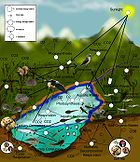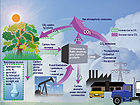- Environmental niche modelling
-
Environmental niche modelling, alternatively known as species distribution modelling, (ecological) niche modelling, and climate envelope modelling refers to the process of using computer algorithms to predict the distribution of species in geographic space on the basis of a mathematical representation of their known distribution in environmental space (= realized ecological niche). The environment is in most cases represent by climate data (such as temperature, and precipitation), but other variables such as soil type, water depth, and land cover can also be used. These models allow for interpolating between a limited number of species occurrence and they are used in several research areas in conservation biology, ecology and evolution.
The extent to which such modelled data reflect real-world species distributions will depend on a number of factors, including the nature, complexity, and accuracy of the models used and the quality of the available environmental data layers; the availability of sufficient and reliable species distribution data as model input; and the influence of various factors such as barriers to dispersal, geological history, or biotic interactions, that increase the difference between the realized niche and the fundamental niche. Environmental niche modelling may be considered a part of the discipline of biodiversity informatics.
Contents
Correlative vs mechanistic models
Environmental niche models are correlative models. They relate observed presences of a species to values of environmental variables at those sites. Some models use absences, as well, but the most commonly used models use presence-only data, perhaps together with 'random background' data. Because they are based on actual distribution of the species, they model the realized niche (resulting of abiotic and biotic constraints) as opposed to the fundamental niche that is solely based on the species' abiotic requirements. In contrast, mechanistic (or process-based) models assess the bio-physiological aspects of a species to generate the conditions in which the species can ideally persist, based on observations made in controlled field or laboratory studies. As such it aims at modelling the fundamental niche of the species. See [1] for a comparison between mechanistic and correlative models.
Niche modelling algorithms
Niche modelling algorithms include "profile methods", simple statistical techniques that use e.g. environmental distance to known sites such as BIOCLIM,[2][3] and DOMAIN. "regression" (e.g. forms of generalized linear models); and "machine learning" methods such as maximum entropy (MAXENT), boosted regression trees (BRTs; also known as gradient boosting methods), and random forest
Niche modelling software
MaxEnt is the most widely used method/software
ModEco implements various algorithms.
DIVA-GIS has an easy to use (and good for educational use) implementation of BIOCLIM
Most niche modelling algorithms are available in the R package 'dismo'.
Software developers may want to build on the openModeller project.
See also
References
- ^ Morin, X.; Thuiller (2009). "Comparing niche- and process-based models to reduce prediction uncertainty in species range shifts under climate change.". Ecology 90 (5): 1301–13. doi:10.1890/08-0134.1. PMID 19537550.
- ^ Nix HA (1986). "BIOCLIM — a Bioclimatic Analysis and Prediction System". Research report, CSIRO Division of Water and Land Resources 1983–1985: 59–60.
- ^ Nix HA (1986). "A biogeographic analysis of Australian elapid snakes". In Longmore. Atlas of Elapid Snakes of Australia. Australian Flora and Fauna Series 7. Bureau of Flora and Fauna, Canberra. pp. 4–15.
Further reading
- Pearson, R.G. (2007). "Species’ distribution modeling for conservation educators and practitioners". Synthesis. American Museum of Natural History. 2007 (?): 1–50. http://biodiversityinformatics.amnh.org/files/SpeciesDistModelingSYN_1-16-08.pdf.
- Elith J., Leathwick J.R. (2009). "Species distribution models: ecological explanation and prediction across space and time". Annual Review of Ecology, Evolution, and Systematics 40: 677–697. doi:10.1146/annurev.ecolsys.110308.120159. http://arjournals.annualreviews.org/doi/pdf/10.1146/annurev.ecolsys.110308.120159.
External links
- openModeller - open source niche modelling library
- lifemapper - niche modelling project from Kansas University
- Lifemapper 2.0 - video of presentation by Aimee Stewart, Kansas University, at O'Reilly Where 2.0 Conference 2008
- AquaMaps - global predictive maps for marine species
- Ecological Modelling - International Journal on Ecological Modelling and Systems Ecology
Categories:- Information science
- Scientific modeling
- Ecology
- Biogeography
- Landscape ecology
Wikimedia Foundation. 2010.



